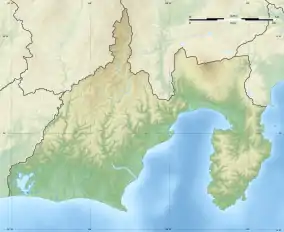Mikuriyama Kofun group
Mikuriyama Kofun group (御厨古墳群, Mikuriyama Kofun gun) is group of kofun burial mounds located in what is now the city of Iwata, Shizuoka in the Tōkai region of Japan. The site was designated a National Historic Site of Japan in 2001.[1]
御厨古墳群 | |
 Mikuriyama Kofun  Mikuriyama Kofun group (Japan) | |
| Location | Iwata, Shizuoka, Japan |
|---|---|
| Region | Tokai region |
| Coordinates | 34°43′11″N 137°53′17″E |
| Type | kofun |
| History | |
| Founded | 3rd to 4th century AD |
| Periods | Kofun |
| Site notes | |
| Ownership | National Historic Site |
| Public access | Yes |
Overview
The site consists of five large burial mounds, located in the Kamata area of what is now the city of Iwata: The Shorinzan Kofun (松林山古墳), Takeneyama Kofun (高根山古墳). Mikuridōyama Kofun (御厨堂山古墳), the Inariyama Kofun (稲荷山古墳) and the Akihayama Kofun (秋葉山古墳). The site is divided by the Tōkaidō Main Line railway tracks, with the Inariyama Kojun and the Akihayama Kofun located to the north of the tracks, and the others to the south.
The largest, the Shorinzan Kofun, is a keyhole-shaped tumulus located on the north side of Shimmei Junior High School and measures approximately 107 meters in length, with a 66.5 meter diameter circular portion and height of 10 meters. An excavation was conducted in 1931, at which time a long stone burial chamber was discovered with a large number of grave goods, including one triangular-rimmed bronze mirror, one bronze mirror depicting four animals, two bronze mirrors depicting flowers, magatama, tubular beads, weapons (straight swords, iron and bronze spears, daggers) and agricultural tools (axes, sickles, saws) were discovered. The mound was covered in fukiishi and the remains of many haniwa were found. From the artifacts, it dates to the second half of the 4th century.
The Takaneyama Kofun is a dome-shaped tumulus with a diameter of 52 meters and height of 8 meters. It is the third largest in the prefecture. The surface was covered with fukiishi and both cylindrical and pot-shaped hanawa. It was built at the end of the 4th century.
The Mikuridōyama Kofun is a keyhole-shaped tumulus with total length of 34,5 meters and height of 4 meters. A mirror and a sword have been recovered from its interior.
The Akihaya Kofun and the Inariyama Kofun are located behind the Buddhist temple of Renjō-ji and are survivors of what was once a group of four tumuli. The largest of this group, the Kyōzuka Kofun (経塚古墳), was a keyhole-shaped tomb with a length of 90 meters, but was destroyed in the early Meiji period to make way for the Tōkaidō Main Line railway, during which time an ancient bronze mirror was recovered. The Akihaya Kofun is dome-shaped, with a diameter of 46 to 50 meters and a height of 8 meters. The Inariyama Kofun is keyhole-shaped, with a total length of 46.5 meters and height of 6 meters. Jar-shaped haniwa have been recovered from the vicinity.
References
- "御厨古墳群" (in Japanese). Agency for Cultural Affairs.
External links
- Iwata city home page (in Japanese)
- Iwata City tourist information (in Japanese) ]
